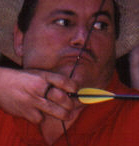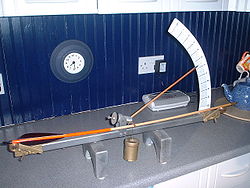AY Honors/Archery - Advanced/Answer Key
Archery - Advanced
Approval authority:
Category:
Skill Level:
Year of Introduction:
![]()
Contents
1. Have the Archery Honor.
For tips and instruction see Archery.
2. Explain the advantages to be found by the target archer in making use of the following equipment:
a. Aluminum shaft target arrows
Aluminum can be made straighter than wood because it does not have a grain and is more durable. However, at the time this honor was written, carbon arrows had not hit the archery scene. Carbon is considered to be more durable than aluminum.
There are 4 types of arrow shafts: Wood, fiberglass, aluminum, carbon.
The carbon arrows are preferred by top archers for their ability to stay straight to .001% straightness. Aluminum arrows were considered best until the mid 1980s.
b. Bow level
A bow level is like any other level. It is a bubble telling you when you have reached a complete vertical or horizontal plane. Bow levels were designed to let the archer know when the bow was straight up and down. These, however, are not allowed in Olympic competition.
c. Bow sight
This is a mechanical device that allows you to aim. It has the ability to adjust for windage (left and right) or elevation (up and down). It is only effective if the archer is shooting the same way every single time. Otherwise, it is useless.
d. Bow sling
The purpose of a bow sling is to keep you from dropping your bow. There are two types of bow slings: the wrist sling and the finger sling.
A wrist sling is a strap that is connected to your bow for you to put your hand through while gripping your bow.
A finger sling is a 2 inch string with a loop at each end. After gripping your bow the loops go over the thumb and your index finger.
e. Bow square
This is a tool that clips onto the string and aligns with the arrow rest to allow you to place the nocking point on the correct spot on the sting.
f. Bow stabilizer(s)
This is a rod or combination of rods that extend out from the bow to be used for the elimination of torque. They vary in length and weight. While most stabilizers all do the same thing, each archer has their preference based on the stability of the shot.
g. Clicker
A mechanical device, usually metal, mounted on the window of the bow used to tell the archer that they are at a full draw by making a "click" sound.
h. Flexible arrow plate
This is an arrow rest which can be adjusted further or closer to the bow, further or closer to the archer and moves out of the way as the arrow passes through the bow allowing for a cleaner shot.
i. Kisser button
A string kisser is a small protrusion placed on the bowstring as an additional reference point. It touches the archers lips, teeth or nose at full draw.
The string "kisser" is a point on the string that touches your lip or corner of your mouth.
If you are using a "center draw" (see, Anchor) the string is in the middle or your chin and the middle of your nose. A "kisser" would be a small disc on the string that would touch your lip. This assures a vertical alignment of your bow.
j. Plastic arrow fletching
Although nothing flies like the feather God created, plastic feathers or "vanes" can be made exactly the same because they are made from a mold. Getting feathers to match by weight and size is difficult on one arrow and even harder to match a dozen. Vanes are more durable and not susceptible to weather conditions.
k. String peep
An aperture in a small round piece of plastic or metal which is set between the strands of a string above the nocking point to sight through and in line with the bow sight.
This is small ring or loop mounted on the string for the eye to look through while sighting. This is one of the items not allowed in Olympic competition.
3. Explain what is meant by arrow spine.
The arrow's resistance to bending classified by hanging a 2lb weight at the center of an arrow resting on two supporting points 26" apart, and measuring the amount of the bend.
"Spine" refers to the weight and flexibility of the shaft and it's relationship to the weight of the bow.
The arrow spine should be matched to the weight of the bow. Spines that are too heavy come out of the bow sluggishly when shot by a light weight bow. Spines that are too weak come out flexing and tweaking as they leave a bow that is too strong.
4. Read the following chapters in The National Archery Association Instructor's Manual:
- a. Problem Correction
This chapter covers problems such as hitting your arm, incorrect stress on the release fingers, etc.
- b. Advanced Shooting
This chapter provides tips on how to achieve absolute stillness from the point of release to arrow clearance and the effect body alignment has on this process.
- c. Bow Tuning
This chapter shows how to adjust the arrow rest, pressure button, string height and nocking point height to achieve good arrow flight out of the bow.
It also describes how the arrow clears the bow, eliminating "nock high", "nock low", left or right clearance problems.
Reading these chapters is lengthy but worthwhile to perfect your shooting. The book was published in 1974, but you may be able to find a used copy at Amazon.com or other online booksellers.
5. Using a standard (Olympic bow) score one of the following:
a. Indoors: 30 arrows (5 rounds) at 18 meters (60 ft.) score 140 points on a 60 cm (23.62 in.) target
b. Outdoors: 30 arrows (5 rounds) at 30 meters (98.42 ft.) score 200 points on a 122 cm (48.03 in.) target.
A standard "Olympic Bow" is a recurve (not compound) bow with no more than 3 stabilizer extensions, a sight, and a clicker. An archer must use fingers and not a mechanical release and may not have a string peep sight or magnified aiming device.
6. Review and practice the archery safety rules.
- Don't shoot straight up.
- Never run on the archery range.
- Approach the target from the side, not the front so you don't get poked by the arrows sticking out of the target.
- Be sure your equipment is in good working order.
- Be aware of who is around you at all times.
- Don't "hide" behind the target.
- Don't walk in front of another archer.
- Don't talk on the shooting line.
- While loading your bow be sure that the arrows are always pointing toward the target.



